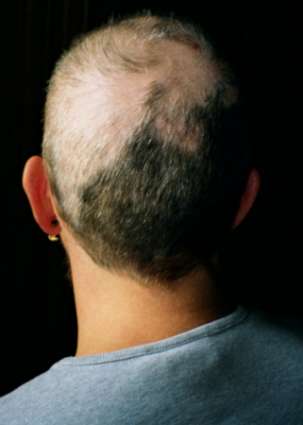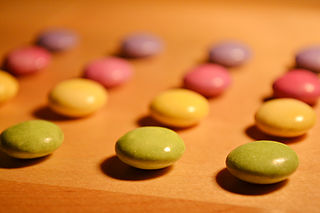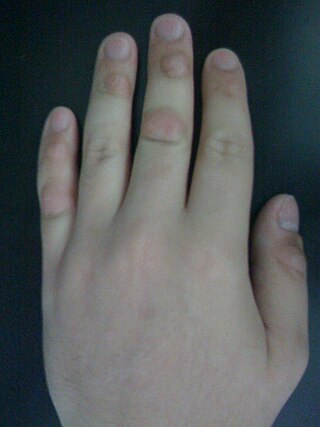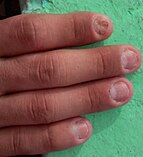
Trichotillomania (TTM), also known as hair-pulling disorder or compulsive hair pulling, is a mental disorder characterized by a long-term urge that results in the pulling out of one's own hair. A brief positive feeling may occur as hair is removed. Efforts to stop pulling hair typically fail. Hair removal may occur anywhere; however, the head and around the eyes are most common. The hair pulling is to such a degree that it results in distress and hair loss can be seen.

Obsessive–compulsive personality disorder (OCPD) is a cluster C personality disorder marked by a spectrum of obsessions with rules, lists, schedules, and order, among other things. Symptoms are usually present by the time a person reaches adulthood, and are visible in a variety of situations. The cause of OCPD is thought to involve a combination of genetic and environmental factors, namely problems with attachment.
Trichophagia is a form of disordered eating in which persons with the disorder suck on, chew, swallow, or otherwise eat hair. The term is derived from ancient Greek θρίξ, thrix ("hair") and φαγεῖν, phagein. Tricho-phagy refers only to the chewing of hair, whereas tricho-phagia is ingestion of hair, but many texts refer to both habits as just trichophagia. It is considered a chronic psychiatric disorder of impulse control. Trichophagia belongs to a subset of pica disorders and is often associated with trichotillomania, the compulsive pulling out of ones own hair. People with trichotillomania often also have trichophagia, with estimates ranging from 48-58% having an oral habit such as biting or chewing, and 4-20% actually swallowing and ingesting their hair. Extreme cases have been reported in which patients consume hair found in the surrounding environment, including the hair of other people and animals. In an even smaller subset of people with trichotillomania, their trichophagia can become so severe that they develop a hair ball. Termed a trichobezoar, these masses can be benign, or cause significant health concerns and require emergency surgery to remove them. Rapunzel syndrome is a further complicaiton whereby the hair ball extends past the stomach and can cause blockages of gastrointestinal system.
Aversion therapy is a form of psychological treatment in which the patient is exposed to a stimulus while simultaneously being subjected to some form of discomfort. This conditioning is intended to cause the patient to associate the stimulus with unpleasant sensations with the intention of quelling the targeted behavior.

Kleptomania is the inability to resist the urge to steal items, usually for reasons other than personal use or financial gain. First described in 1816, kleptomania is classified in psychiatry as an impulse control disorder. Some of the main characteristics of the disorder suggest that kleptomania could be an obsessive-compulsive spectrum disorder, but also share similarities with addictive and mood disorders.
Impulse-control disorder (ICD) is a class of psychiatric disorders characterized by impulsivity – failure to resist a temptation, an urge, or an impulse; or having the inability to not speak on a thought. Many psychiatric disorders feature impulsivity, including substance-related disorders, behavioral addictions, attention deficit hyperactivity disorder, autism spectrum disorder, fetal alcohol spectrum disorders, antisocial personality disorder, borderline personality disorder, conduct disorder and some mood disorders.

Excoriation disorder, more commonly known as dermatillomania, is a mental disorder on the obsessive–compulsive spectrum that is characterized by the repeated urge or impulse to pick at one's own skin, to the extent that either psychological or physical damage is caused.
Stereotypic movement disorder (SMD) is a motor disorder with onset in childhood involving restrictive and/or repetitive, nonfunctional motor behavior, that markedly interferes with normal activities or results in bodily injury. To be classified as SMD, the behavior in question must not be due to the direct effects of a substance, autism, or another medical condition. The cause of this disorder is not known.
Autophagia refers to the practice of biting/consuming one's body. It is a sub category of self-injurious behavior (SIB). Commonly, it manifests in humans as nail biting and hair pulling. In rarer circumstances, it manifests as serious self mutilative behavior such as biting off one's fingers. Autophagia affects both humans and non humans. Human autophagia typically occurs in parts of the body that are sensitive to pain, such as fingers. Human autophagia is not motivated by suicidal intent, but may be related to the desire to seek pain.
Habit reversal training (HRT) is a "multicomponent behavioral treatment package originally developed to address a wide variety of repetitive behavior disorders".
The obsessive–compulsive spectrum is a model of medical classification where various psychiatric, neurological and/or medical conditions are described as existing on a spectrum of conditions related to obsessive–compulsive disorder (OCD). "The disorders are thought to lie on a spectrum from impulsive to compulsive where impulsivity is said to persist due to deficits in the ability to inhibit repetitive behavior with known negative consequences, while compulsivity persists as a consequence of deficits in recognizing completion of tasks." OCD is a mental disorder characterized by obsessions and/or compulsions. An obsession is defined as "a recurring thought, image, or urge that the individual cannot control". Compulsion can be described as a "ritualistic behavior that the person feels compelled to perform". The model suggests that many conditions overlap with OCD in symptomatic profile, demographics, family history, neurobiology, comorbidity, clinical course and response to various pharmacotherapies. Conditions described as being on the spectrum are sometimes referred to as obsessive–compulsive spectrum disorders.

Dermatophagia or dermatodaxia is a compulsion disorder of gnawing or biting one's own skin, most commonly at the fingers. This action can either be conscious or unconscious. Those affected with dermatophagia typically bite the skin around the nails, leading to bleeding and discoloration over time. Some people also bite on their skin on their finger knuckles which can lead to pain and bleeding just by moving their fingers. In herpetology, dermatophagia is used to correctly describe the act in which amphibians and reptiles eat the skin they shed, but this is not what occurs in humans. Those diagnosed with this disorder do not develop wounds on the bitten areas of their hands or lose any skin. Instead, they experience a thickening of the skin being repeatedly bitten. Contemporary research suggests a link between impulse-control disorders and obsessive–compulsive disorders, and this was addressed in the DSM-5 when dermatophagia and other related disorders were classified as 'other specified obsessive-compulsive related disorders' and are given the specification of body focused repetitive behavior.
Misophonia is a disorder of decreased tolerance to specific sounds or their associated stimuli, or cues. These cues, known as "triggers", are experienced as unpleasant or distressing and tend to evoke strong negative emotional, physiological, and behavioral responses that are not seen in most other people. Misophonia and misophonic symptoms can adversely affect the ability to achieve life goals and enjoy social situations. It was first recognized in 2001, though it is still not in the DSM-5 or any similar manual. For this reason it has been called a "neglected disorder".

Obsessive–compulsive disorder (OCD) is a mental and behavioral disorder in which an individual has intrusive thoughts and feels the need to perform certain routines (compulsions) repeatedly to relieve the distress caused by the obsession, to the extent where it impairs general function.
Onychotillomania is a compulsive behavior in which a person picks constantly at the nails or tries to tear them off. It is not the same as onychophagia, where the nails are bitten or chewed, or dermatillomania, where skin is bitten or scratched. Onychotillomania can be categorized as a body-focused repetitive behavior in the DSM-5 and is a form of skin picking, also known as excorciation disorder.

Body-focused repetitive behavior (BFRB) is an umbrella name for impulse control behaviors involving compulsively damaging one's physical appearance or causing physical injury.
Morsicatio buccarum is a condition characterized by chronic irritation or injury to the buccal mucosa, caused by repetitive chewing, biting or nibbling.
Daniel A. Geller is an Australian American pediatrician and psychiatrist who specializes in the treatment of pediatric obsessive–compulsive disorder (OCD). Geller is triple board certified in Pediatrics, Psychiatry, and Child & Adolescent Psychiatry, and is director of the Pediatric OCD Program at Massachusetts General Hospital.
Decoupling is a behavioral self-help intervention for body-focused and related behaviors (DSM-5) such as trichotillomania, onychophagia, skin picking and lip-cheek biting. The user is instructed to modify the original dysfunctional behavioral path by performing a counter-movement shortly before completing the self-injurious behavior. This is intended to trigger an irritation, which enables the person to detect and stop the compulsive behavior at an early stage. A systematic review from 2012 suggested some efficacy of decoupling, which was corroborated by Lee et al. in 2019. Whether or not the technique is superior to other behavioral interventions such as habit reversal training awaits to be tested. Decoupling is a variant of habit reversal training.

Habit-tic deformity is a condition of the nail caused by external trauma to the nail matrix. The condition is characterized by ridges which run horizontally across the entire nail, most often occurring on the thumbs, as well as marked damage to or absence of cuticles.









